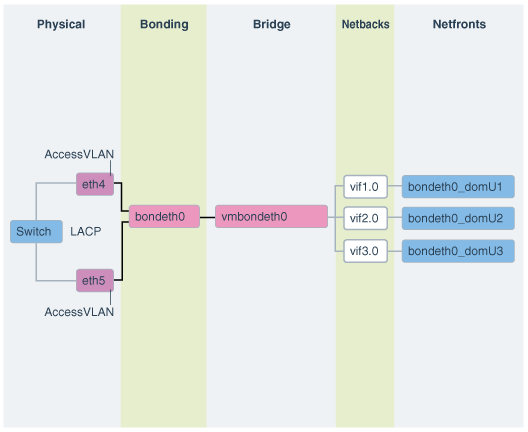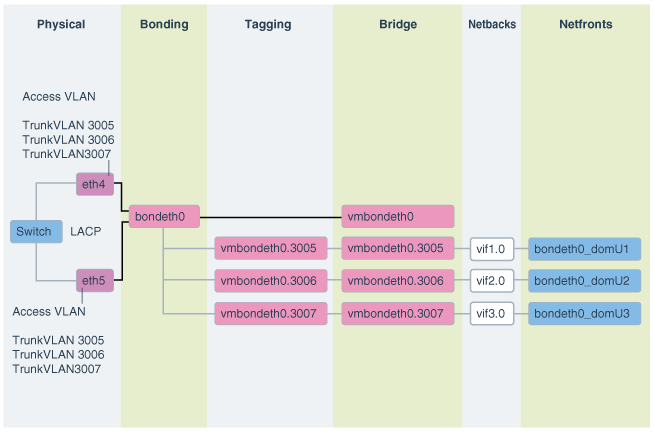5.23 Implementing Tagged VLAN Interfaces
This topic describes the implementation of tagged VLAN interfaces in Oracle VM environments on Exadata.
Oracle databases running in Oracle VM guests on Oracle Exadata Database Machine are accessed through the client Ethernet network defined in the Oracle Exadata Deployment Assistant (OEDA) configuration tool. Client network configuration in both the management domain (dom0) and user domains (domU's) is done automatically when the OEDA installation tool creates the first user domain during initial deployment.
The following figure shows a default bonded client network configuration:
Figure 5-1 NIC Layout in an Oracle Virtual Environment

Description of "Figure 5-1 NIC Layout in an Oracle Virtual Environment"
The network has the following configuration:
-
In the dom0, eth slave interfaces (for example, eth1 and eth2, or eth4 and eth5) that allow access to the domU client network defined in OEDA are discovered, configured, and brought up, but no IP is assigned.
-
In the dom0, bondeth0 master interface is configured and brought up, but no IP is assigned.
-
In the dom0, bridge interface vmbondeth0 is configured, but no IP is assigned.
-
In the dom0, one virtual backend interface (vif) per domU that maps to that particular domU's bondeth0 interface is configured and brought up, but no IP is assigned. These vifs are configured on top of the bridge interface vmbondeth0, and the mapping between the dom0 vif interface and its corresponding user domain interface bondeth0 is defined in the user domain configuration file called
vm.cfg, located in/EXAVMIMAGES/GuestImages/user domain name.
For default installations, a single bondeth0 and a corresponding vmbondeth0 bridge interface is configured in the dom0 as described above. This bondeth0 interface is based on the default Access Virtual Local Area Network (Access VLAN). The ports on the switch used by the slave interfaces making up bondeth0 are configured for Access VLAN.
Using VLAN Tagging
If there is a need for virtual deployments on Exadata to access additional VLANs on the client network, such as enabling network isolation across user domains, then 802.1Q-based VLAN tagging is a solution. The following figure shows a client network configuration with VLAN tagging.
Figure 5-2 NIC Layout for Oracle Virtual Environments with VLAN Tagging

Description of "Figure 5-2 NIC Layout for Oracle Virtual Environments with VLAN Tagging"
For instructions on how to configure and use such additional VLAN tagged interfaces on the client network, see My Oracle Support note 2018550.1. The Access VLAN must stay working and configured before and after these instructions are followed. At no time is the Access VLAN to be disabled.